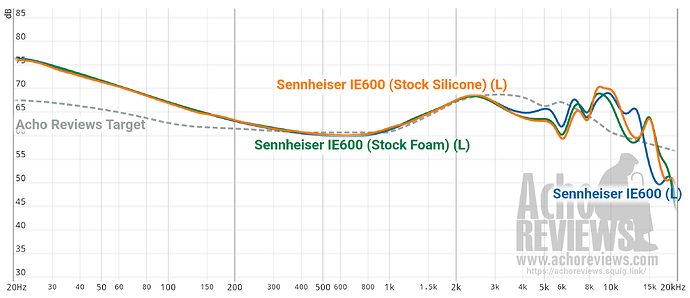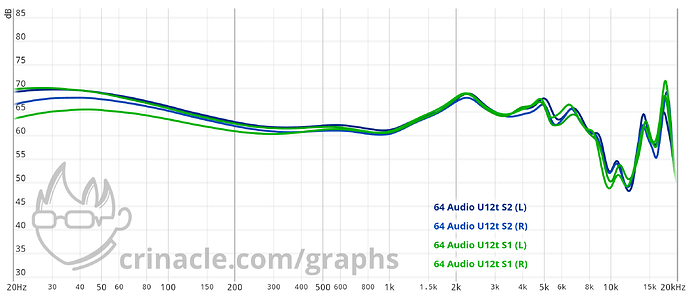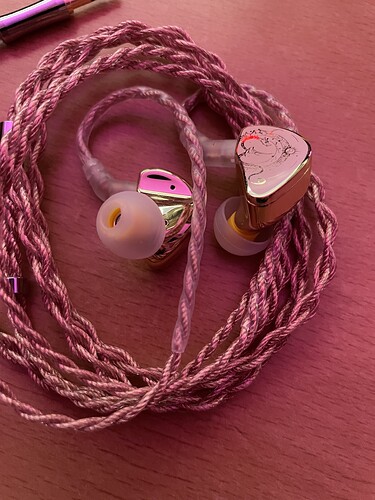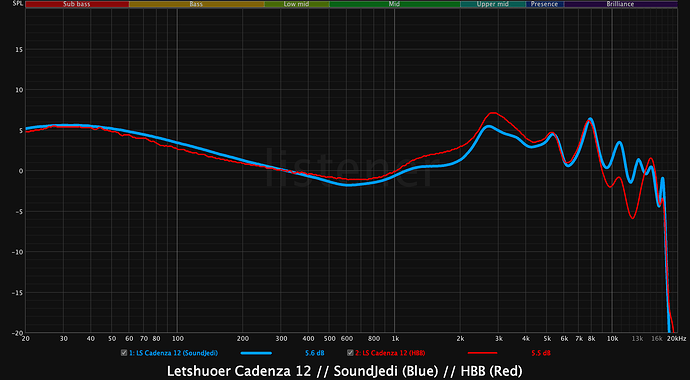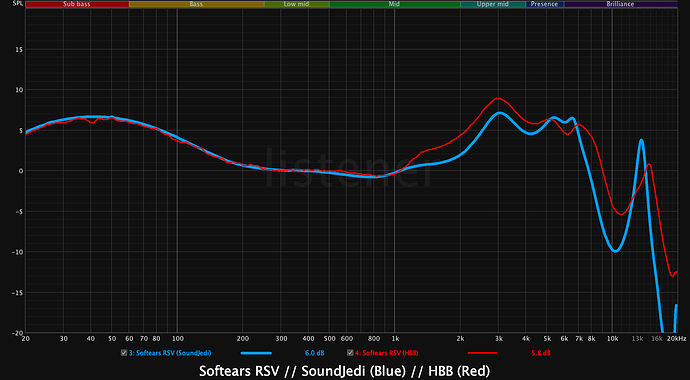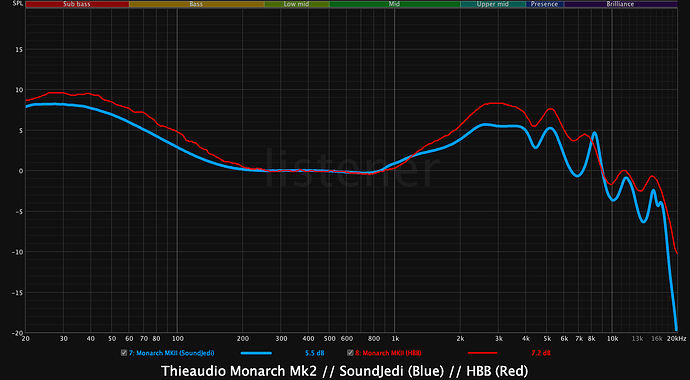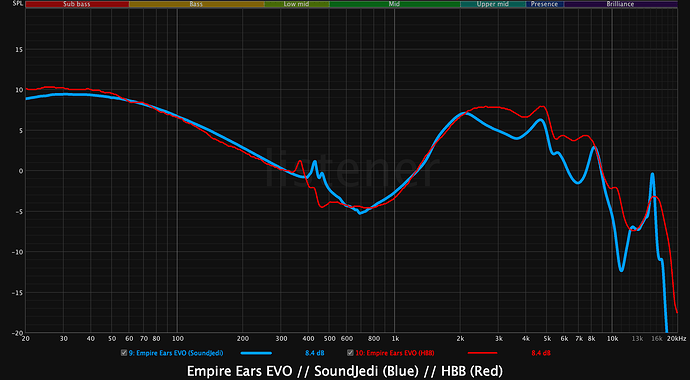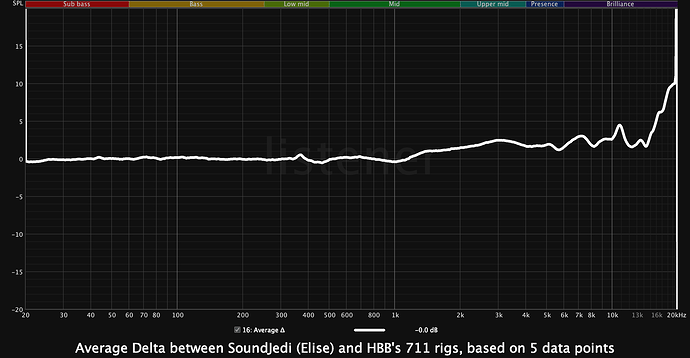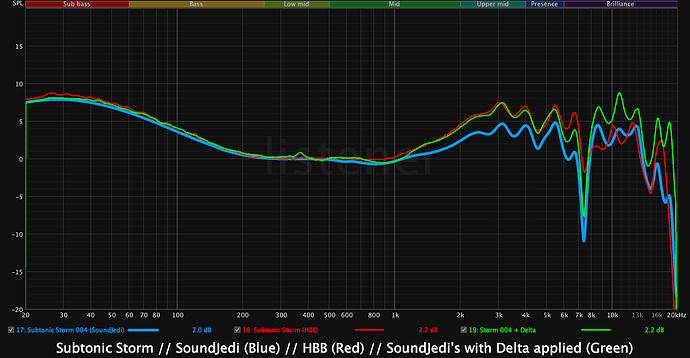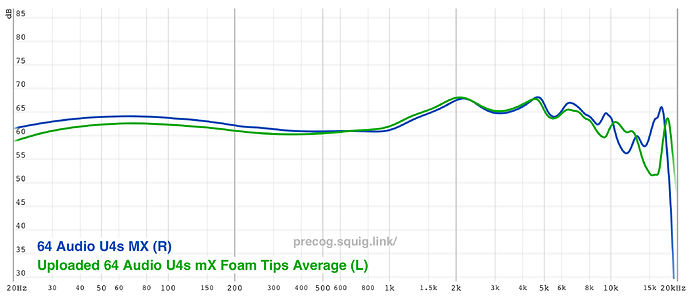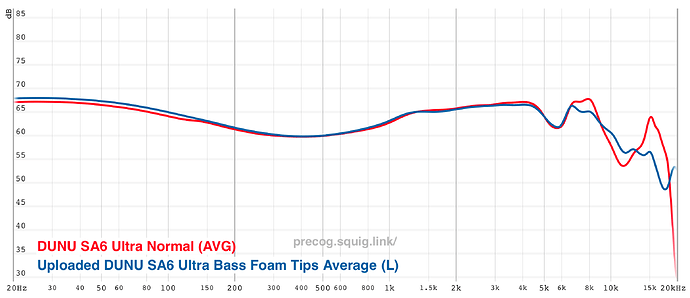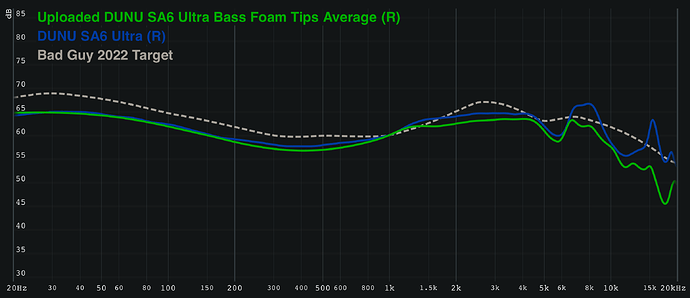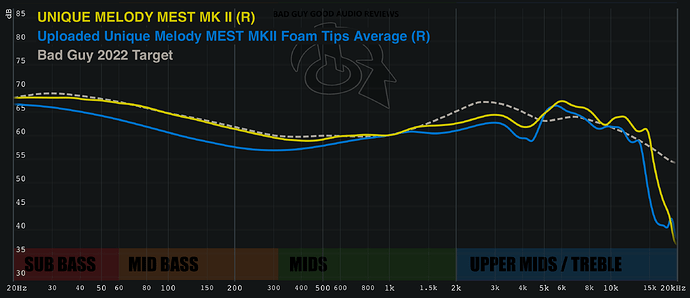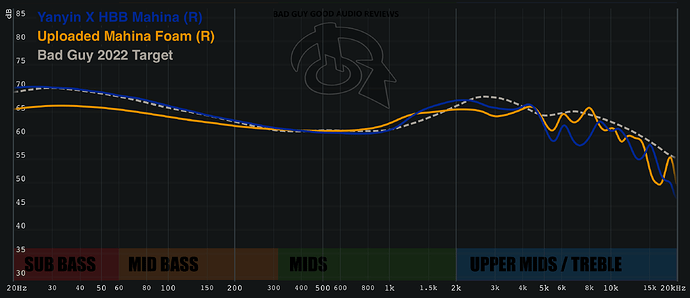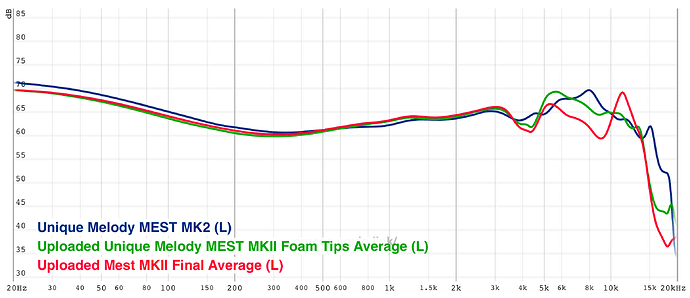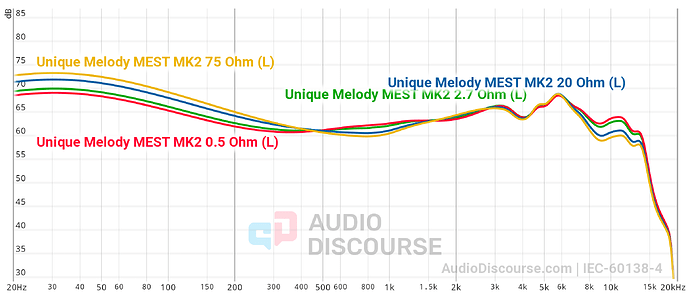I remember hearing this as well but I’ve since measured the same IEM with different tips on 3 different 711 rigs and they all produced pretty much the exact same results. Especially the exact same below about 5 KHz so I believe this is complete bullsh!t. These rigs, however knock-offs, are actually surprisingly accurate.
Oh you’ve also tried measuring the same IEMs on different 711 rigs and gotten different results??
I have measured the exact same iems on multiple rigs and while the results have been similar, there are differences.
Also, different tips on the same rig produce different results, so maybe yours was coincidence?
I mean thanks for proving my point as it’s basically the exact same up until about 3 Khz!
Sorry one last point on QC vs rig… Well here is the same rig measuring two different IEMs of the same make and model. I’m sure some of you have seen this before but it bears keeping in mind…
Not even any of the stock ones?
The stock ones sizing is just barely too big or too small for my ears to maintain a really good seal. They work, but have occasional problems losing seal when I’m moving around.
I’m using Moondrop Spring XL tips, but Spinfit cp100 also work well I just prefer the Spring tips for the extra grip.
For once you dont know if people have/use the manufacturers calibration file. And its not necessarily a given that thats accurate. My calibration shows deviations starting at 1k. While the magnitude of the deviation is only about 1dB it shows a similar form to the mentioned IEF comp from Super. I dont know how exactly he came to that but there it varies up to 3-4 dB in the 1-3k area, which is how the storm deviates. As with all things you can have statistical bad luck with the rig accuracy, seating, or other variances.
In this instance Id probably trust HBBs experience and assume its the rigs fault.
I got both stock types to work for me, but I’ll do some rolling tonight and report back. The KZ x HBB PR2 has been a struggle getting a solid fit for some odd reason, but I’ve been having great luck with Symbio W tips.
Edit: @Pokrog I’m really digging these with Sprial Dots and Sedna Earfit Light Shorts if you have any at hand; I think the wide bores help to balance the sound very well, still hitting hard in the lows with more breathing room for the mids and highs.
Since you seem to be thoroughly unfamiliar with the differences of these rigs, let me throw some data out there to help educate.
First thing: remember that IEC spec only dictates consistent simulation within the range of 100Hz up to wherever the resonance frequency as a result of insertion depth lies.
Here is measurements of the Letshuoer Cadenza 12 on both SoundJedi and HBB’s clone 711 rigs. You’ll notice that they are quite different in the mids, especially around 1-4kHz. Do you think this is Letshuoer’s fault, or do you think the difference of the rigs may have something to do with it?
Here is measurements of the Softears RSV on both SoundJedi and HBB’s clone 711 rigs. You’ll notice that they are quite different in the mids, especially above 1kHz. Do you think this is Softears’s fault, or do you think the difference of the rigs may have something to do with it?
Here is measurements of the Sennheiser IE600 on both SoundJedi and HBB’s clone 711 rigs. You’ll notice that they are quite different in the mids, especially above 1kHz. Do you think this is Sennheiser’s fault, or do you think the difference of the rigs may have something to do with it?
Here is measurements of the Thieaudio Monarch Mk2 on both SoundJedi and HBB’s clone 711 rigs. You’ll notice that they are quite different in the mids, especially above 1kHz. Do you think this is Thieaudio’s fault, or do you think the difference of the rigs may have something to do with it?
Here is measurements of the Empire Ears EVO on both SoundJedi and HBB’s clone 711 rigs. You’ll notice that they are quite different in the mids, especially above 1kHz. Do you think this is Empire Ears’s fault, or do you think the difference of the rigs may have something to do with it?
In case it’s not obvious, I’m showing data between the two rigs in question to show you what many of us already know. Clone 711 rigs are inconsistent as heck, and SoundJedi (Elise Audio) in particular has one known by many to be consistently recessed between 1-8kHz. I know you didn’t know this, so you didn’t know that your callout of Subtonic was completely erroneous.
As a follow-up, here’s the average delta between the two rigs, where you can see SoundJedi’s meaningfully (and very widely) underestimates response above 1kHz vs HBB’s 711 rig.
And lastly, here’s SoundJedi’s Storm measurement with the delta between the two rigs applied in Green
Seems like the QC is probably pretty excellent and the entire difference here is up to rigs ![]()
@hawaiibadboy since the topic of graphs got brought maybe you can help a newb clear up some confusion. I’m not here attacking anyone just trying to understand what could cause this level of variation. I get couplers can produce variances and we can argue all day about what frequencies they occur at. It’s weird to me though that my measurements will line up to @Precogvision nearly identical and to some extend even yours yet then they’ll be wild differences that don’t even seem to point to the same IEM. Screenshots below for reference.
Here’s my U4s and SA6U measurement compared to precog. Results appear pretty consistent.
Here’s my Legato and SA6U on your database and it’s still looking fairly consistent. Starting to get a bit of though.
Then there’s yikes ![]() are they even the same IEM.
are they even the same IEM.
Then to make matters even more confusing to me here’s my Mest MKII on precogs. Which brings it back to looking a lot more alike.
For clarification all my measurements are done four times on left and right channel. The same XINHs cable is used for all measurements. Between each measurement the IEM is taken out of the coupler, tip removed and put back on and then inserted into coupler for the next measurement. If the measurement graphs the same only then do I rule out me being the issue.
Could this be a matter of us graphers rushing measurements? Could it be differences in the json file producing the graph from our measurement? I’ve noticed reviewing source code on each of our databases some variations in the json that lead me to believe it could be the issue. Either way it perplexes me that some could line up so identical and yet others be so off. Just looking for general input and thought.
This gets into the issue of transfer functions, specifically the “headphone-to-eardrum” transfer function.
Every IEM, especially ones with different driver principles, chassis designs, tips etc., will all have a different acoustic pathway to the ear, and therefore a different group of resistances (in the aggregate we call this “acoustic impedance”) changing the way the sound travels to the eardrum.
I believe what you’re seeing here is the difference between each earphone’s “headphone-to-ear transfer function,” and indeed this can be seen on both IEMs as well as headphones.
I’d agree if we were measuring from our eardrum. However, most of us are all using clone couplers that have the same cylinder insertion point which should eliminate that variable for a large part. I’d also think if what you mentioned was a variable I wouldn’t see similar results with HBB on some measurements.
There are a lot of reasons why measurements between different databases won’t be consistent. Even measurements between IEMs taken on the same coupler shouldn’t be considered entirely consistent. To break down a few of the common reasons:
-
Ear tips - ear tip selection, especially between silicone vs. foam tips, will usually subtly change the frequency response by rolling off the highs more in the case of foam ear tips. This doesn’t usually matter, but some manufacturers aren’t 100% consistent with their ear tip production (within the same size) so some are shaped slightly differently. Good practice is to use the same ear tip on both sides
-
Insertion depth - ear tip selection also plays into insertion depth on the coupler. Insertion depth can make a major difference between measurements depending on whether an IEM has a true peak or delta in certain regions. A good example of this is the Sennheiser IE600/IE900 IEMs
-
Coupler differences - individual rigs have good amounts of variability past 10kHz. For example, mine tends to be more rolled-off in those regions whereas Crin’s more accurately reflects upper-treble energy (at least relative to how I hear it). Another example is my coupler compared to Super*Review’s which tends to measure with less pinna gain IIRC
-
Source impedance - this is a subtle one that gets missed a lot. Depending on what you’re plugging the IEM into to perform the measurement, the impedance of your source can affect the FR. Depends on how sensitive the IEM is, but there are definitely some IEMs out there that will change FR even with slightly higher impedance (the CFA Andro is a good example)
-
Unit variation - ignoring all else, there are subtle variances between driver components; most manufacturers aim for correct channel matching - think consistency - rather than accuracy. Otherwise there’d be a lot of discarded components
The bottom line is that it doesn’t make sense to compare measurements taken off different couplers because there’s too many variables to control for. Most people don’t even list the tips they use (I know I rarely do). And if you look closely between measurements, you’ll often see that the coupler resonance is at a slightly different spot which indicates the insertion depth was different (which can have a big impact as I noted above). Now, if something looks dramatically different, it might suggest there’s cause for concern but there’s a lot of limitations that have to be kept in mind.
I love playing with graphs, squigs, and making observational comparisons more than most, but I think one thing to keep strongly in mind:
Graphs are an approximation measurement of what is happening. They neither replace actually hearing an IEM, nor should they stand as an end-all be-all. I find graphs to be most representative of an outline of what you should expect (as a foundation) to hear when listening to an IEM.
When I compare across databases, I’m only really seeing if the general shape of the graphs match up. While SoundJedi’s measurements are more recessed and never match up with HBBs, the SHAPE of his measurements is in line with the shape of HBBs. The amplitudes may not read accurately but both sets of the IEMs are doing what you should expect the IEM to do. What it actually sounds like comes down to hearing them, but when comparing the two, I wouldn’t expect the set HBB measured to be radically different from the set SoundJedi measured.
It’s a good reminder that none of the measurement databases do apples-to-apples comparisons, but it’s not like we’re doing apples-to-charcoal comparisons either. But as much as we want to treat this as science, there’s a lot of art and interpretation in it too
I think you are missing his point. The graphs he showed were two samples of the U12t in crinacles graph db (same coupler) so it has nothing to do with different rigs. One of those samples has crazy bad channel imbalance. The other is just regular bad ![]()
First and for most thank for the in depth response and taking your time to stop by and drop some knowledge. A few key points that were of interest to me that you elaborated on more.
I realized there were variances but, didn’t realize they could be so in depth.
Definitely didn’t consider this. Could it cause such a skewed result as seen? On a side note maybe it would be worth updated my graph to include the source used at least as a cliff note. Which as of know is the one sold at CollegeStore where I also got the Coupler. Could also be fun to possibly get into graphing the same IEM with different sources eventually and report results.
This is a point a never thought to consider in this manner. Thanks for the knowledge.
I realized this for the most part. Starting my own database was mostly to fulfill me liking to tinker with new stuff IT related. With the side benefit having my own comparison database of IEMs I’ve heard and to give a little back to the community that has helped me tremendously. Graphing is way quicker than reviews and fits into my family schedule better.
